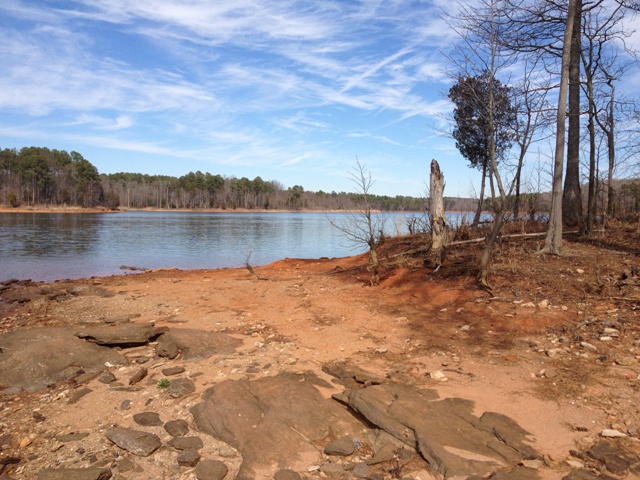City officials will break ground this summer on a new 600-acre Raleigh “metro” park intended to attract visitors from around the Triangle.
Forest Ridge Parkwill occupy the wooded peninsula between the Falls Lake dam and Highway 98, anchoring the northern end of the Upper Neuse River Greenway.

The view from shore near the site of the future Forest Ridge Park. Photo by Dan Riechers..
Features include hiking trails, disc golf and picnic areas. One of the biggest draws will be five miles of single-track mountain biking trails. Such trails are much-needed amenity in the Triangle, according to Matt Jenkins, president of Triangle Off-Road Cyclists (TORC).
“This is an area that has been underserved,” he said.
He credits the work of Bill Camp, TORC’s first president, who attended many of the park planning meetings.
“It’s been a long road to get here,” Jenkins said. “We’re patient people, and we’d rather have an official trail, built right, with permission, that’s going to be there for years for people to enjoy, than one that’s scratched out somewhere in a soon-to-be-shopping center.”
Not everyone is as enthusiastic about the park.
The Wakefield Estates community, situated closest to the park and with the entrance road running through their neighborhood, expressed mixed views during the public comment period in 2006. Some residents lauded the city’s efforts to finally move ahead with the park, while others expressed concern about increased traffic volume and privacy.
The U.S. Army Corps of Engineers plan for Falls Lake has always included a park at Forest Ridge. Original plans called for camp sites close to the water and a larger amount of developed area that would have increased water pollution at a critical point, right next to the city’s drinking water intake.
New park plans still place the park next to Raleigh’s drinking-water intake. But Carol Banaitis, project manager for the U.S. Army Corps of Engineers at Falls Lake, said, “there are strong rules in place to protect the water quality of Falls Lake.”

A rendering of the future Forest Ridge Welcome Center.
The city is required to comply with the Neuse River Buffer Rules and the Falls Lake Rules, Banaitis said. The rules limit human activity in the watershed to prevent pollution from reaching the lake.
The new park design uses low impact development practices and the architecture will meet Leadership in Energy and Environmental Design (LEED) silver standards. The design calls for a protective buffer along the lakeshore and the use of best management practices to manage runoff.
The city will pay for the first phase of park construction with up to $6.26 million from a 2003 Park and Greenway Bond Referendum.
David Berra, landscape architect with Raleigh, said the city has spent $610,000 so far, including $486,000 to HadenStanziale to develop a master plan for the project, facilitate public meetings and assist with permitting.
The city is paying for the mountain biking trails with a $75,000 grant from the Department of Environment and Natural Resources. The city has signed an agreement with Native Trails, a trail development company, to complete the trail.
The trails and disc golf course will open after bathrooms and parking lots are in place in late 2013. In addition to recreation areas, the city will construct a 3,000-square-foot classroom building and welcome center.
Plans for later phases include a fishing pier, paddle-boating areas, a small amphitheater, group camping and an adventure center.
